Leadership & Management Theories & Practices in Health Care
VerifiedAdded on 2023/06/09
|23
|2094
|76
Presentation
AI Summary
This presentation provides an overview of key leadership and management theories relevant to the health and social care sector, with a focus on Treetops Care Home. It analyzes transformational, situational, and bureaucratic theories, discussing their advantages and disadvantages in a workplace context. The presentation evaluates the challenges of leadership and management in health and social care, including rising costs and influencing factors on staff performance, such as hectic schedules and non-cooperative patients. It also highlights factors contributing to job satisfaction, the role of performance management, and different models of team leadership, such as the Lencioni and Tuckman models. The roles and benefits of teams, along with individual responsibilities and accountabilities, are examined within a health and social care setting. The presentation concludes by emphasizing the importance of problem-solving in policy development and implementation, and the overall significance of leadership and management theories in enhancing efficiency and service quality.

PRINCIPLES OF
LEADERSHIP AND
MANAGEMENT
LEADERSHIP AND
MANAGEMENT
Paraphrase This Document
Need a fresh take? Get an instant paraphrase of this document with our AI Paraphraser

Table of Content
Introduction
Analysis of key leadership and management theories
Advantages and disadvantages of transformational theory of leadership within the
workplace
Situational leadership theory
The advantages and disadvantages of theory in context of an enterprise
Bureaucratic theory of management
Bureaucratic theory : Pros & Cons
Evaluation of the challenges of leadership and management in health and social care
sector
Examination of the influencing factors on staff performance in Treetops Care Home
Introduction
Analysis of key leadership and management theories
Advantages and disadvantages of transformational theory of leadership within the
workplace
Situational leadership theory
The advantages and disadvantages of theory in context of an enterprise
Bureaucratic theory of management
Bureaucratic theory : Pros & Cons
Evaluation of the challenges of leadership and management in health and social care
sector
Examination of the influencing factors on staff performance in Treetops Care Home

Contd.
Key factors that contributes to job satisfaction
Role of performance management in the success of health care organizations
Different models of team leadership
Roles of teams and benefits of having teams in health and social care
Roles and responsibilities, accountabilities and duties in a social and health
care setting
Evaluation of the contribution of one key role in the development and
implementation of Health and social care organizational policy
Conclusion
References
Key factors that contributes to job satisfaction
Role of performance management in the success of health care organizations
Different models of team leadership
Roles of teams and benefits of having teams in health and social care
Roles and responsibilities, accountabilities and duties in a social and health
care setting
Evaluation of the contribution of one key role in the development and
implementation of Health and social care organizational policy
Conclusion
References
⊘ This is a preview!⊘
Do you want full access?
Subscribe today to unlock all pages.

Trusted by 1+ million students worldwide

Introduction
Management can be understood as controlling the group and to set the entities in order
to accomplish the goals.
Leadership refers to an individual’s ability to influence, motivate and set individual
goals for team to deliver best outcome of any task.
Following presentation is based on tree tops care ltd, they provides the care for elderly.
Management can be understood as controlling the group and to set the entities in order
to accomplish the goals.
Leadership refers to an individual’s ability to influence, motivate and set individual
goals for team to deliver best outcome of any task.
Following presentation is based on tree tops care ltd, they provides the care for elderly.
Paraphrase This Document
Need a fresh take? Get an instant paraphrase of this document with our AI Paraphraser

Analysis of key leadership and management
theories
There are different theories of leadership and management that can be implemented
within an enterprise. These have been explained below:
Transformational leadership theory
This theory of leadership can be explained as a type of leadership where a leader makes
an effort in order to communicate and interact with the team members working within
an enterprise.
Here, the leader tries to interact with the team members in order to determine the need
of change within the organizational setting and help the company in enhancing the
productivity and efficiency of the workforce within the organization.
theories
There are different theories of leadership and management that can be implemented
within an enterprise. These have been explained below:
Transformational leadership theory
This theory of leadership can be explained as a type of leadership where a leader makes
an effort in order to communicate and interact with the team members working within
an enterprise.
Here, the leader tries to interact with the team members in order to determine the need
of change within the organizational setting and help the company in enhancing the
productivity and efficiency of the workforce within the organization.
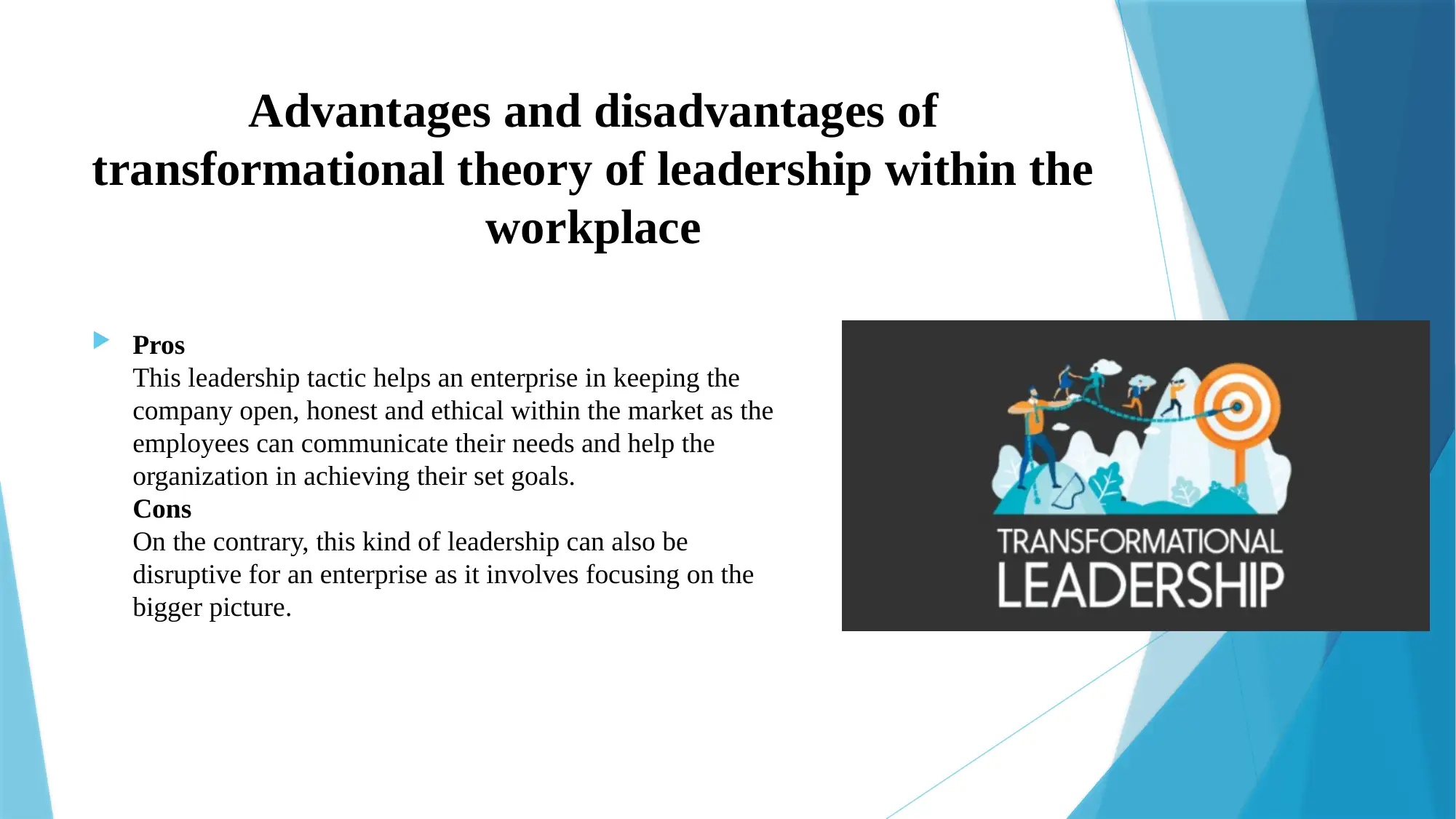
Advantages and disadvantages of
transformational theory of leadership within the
workplace
Pros
This leadership tactic helps an enterprise in keeping the
company open, honest and ethical within the market as the
employees can communicate their needs and help the
organization in achieving their set goals.
Cons
On the contrary, this kind of leadership can also be
disruptive for an enterprise as it involves focusing on the
bigger picture.
transformational theory of leadership within the
workplace
Pros
This leadership tactic helps an enterprise in keeping the
company open, honest and ethical within the market as the
employees can communicate their needs and help the
organization in achieving their set goals.
Cons
On the contrary, this kind of leadership can also be
disruptive for an enterprise as it involves focusing on the
bigger picture.
⊘ This is a preview!⊘
Do you want full access?
Subscribe today to unlock all pages.

Trusted by 1+ million students worldwide

Situational leadership theory
This theory of leadership can be explained as a style of
leadership that is followed by leaders within enterprises where
they try to analyse the efficiency of each and every individual
within the company with respect to the different situations that
might arise.
With the use of this kind of leadership, the organizational
setting including the health care sector aims to prepare their
employees in order to face each and every situation associated
with the company.
This theory of leadership can be explained as a style of
leadership that is followed by leaders within enterprises where
they try to analyse the efficiency of each and every individual
within the company with respect to the different situations that
might arise.
With the use of this kind of leadership, the organizational
setting including the health care sector aims to prepare their
employees in order to face each and every situation associated
with the company.
Paraphrase This Document
Need a fresh take? Get an instant paraphrase of this document with our AI Paraphraser
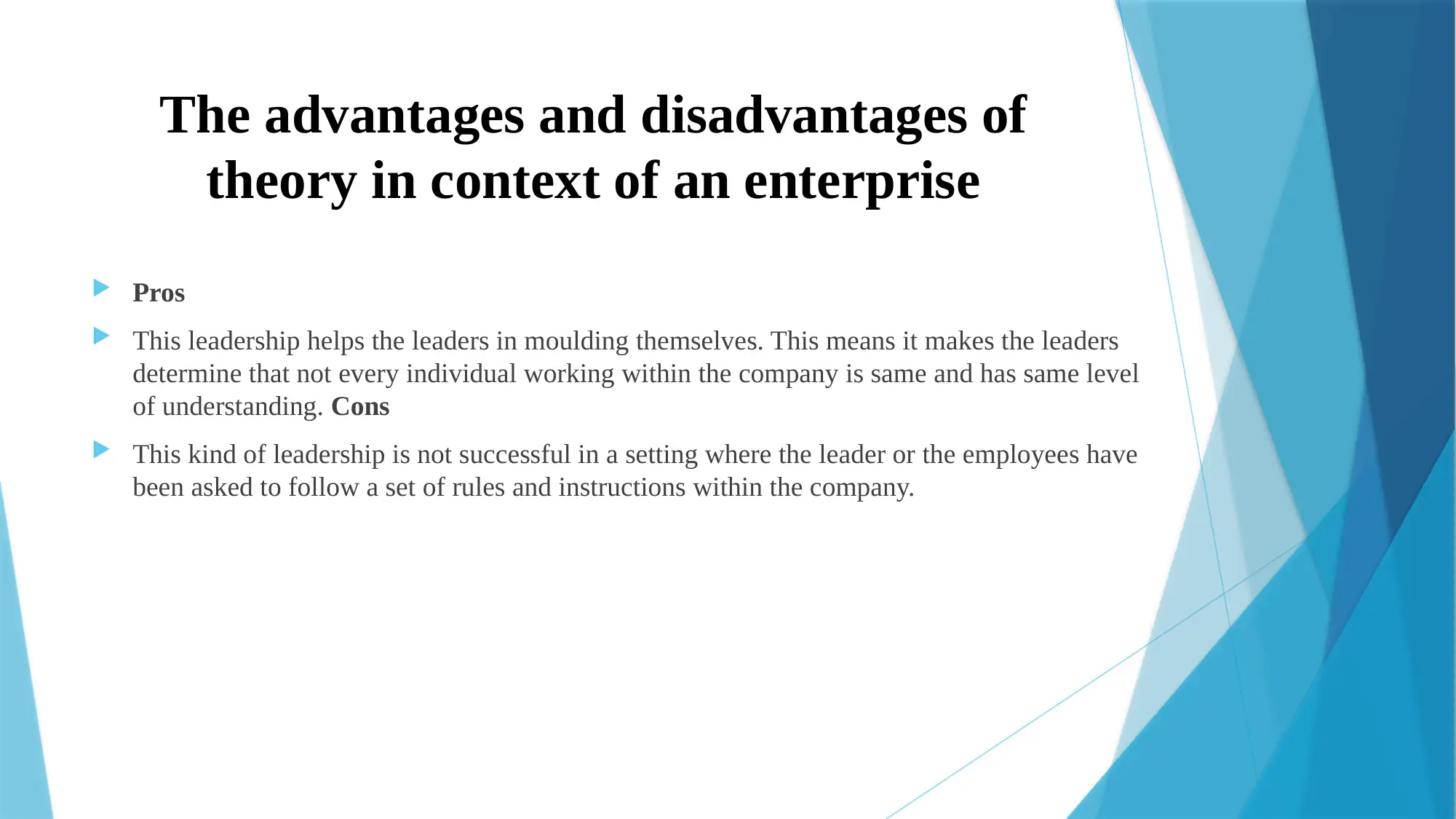
The advantages and disadvantages of
theory in context of an enterprise
Pros
This leadership helps the leaders in moulding themselves. This means it makes the leaders
determine that not every individual working within the company is same and has same level
of understanding. Cons
This kind of leadership is not successful in a setting where the leader or the employees have
been asked to follow a set of rules and instructions within the company.
theory in context of an enterprise
Pros
This leadership helps the leaders in moulding themselves. This means it makes the leaders
determine that not every individual working within the company is same and has same level
of understanding. Cons
This kind of leadership is not successful in a setting where the leader or the employees have
been asked to follow a set of rules and instructions within the company.
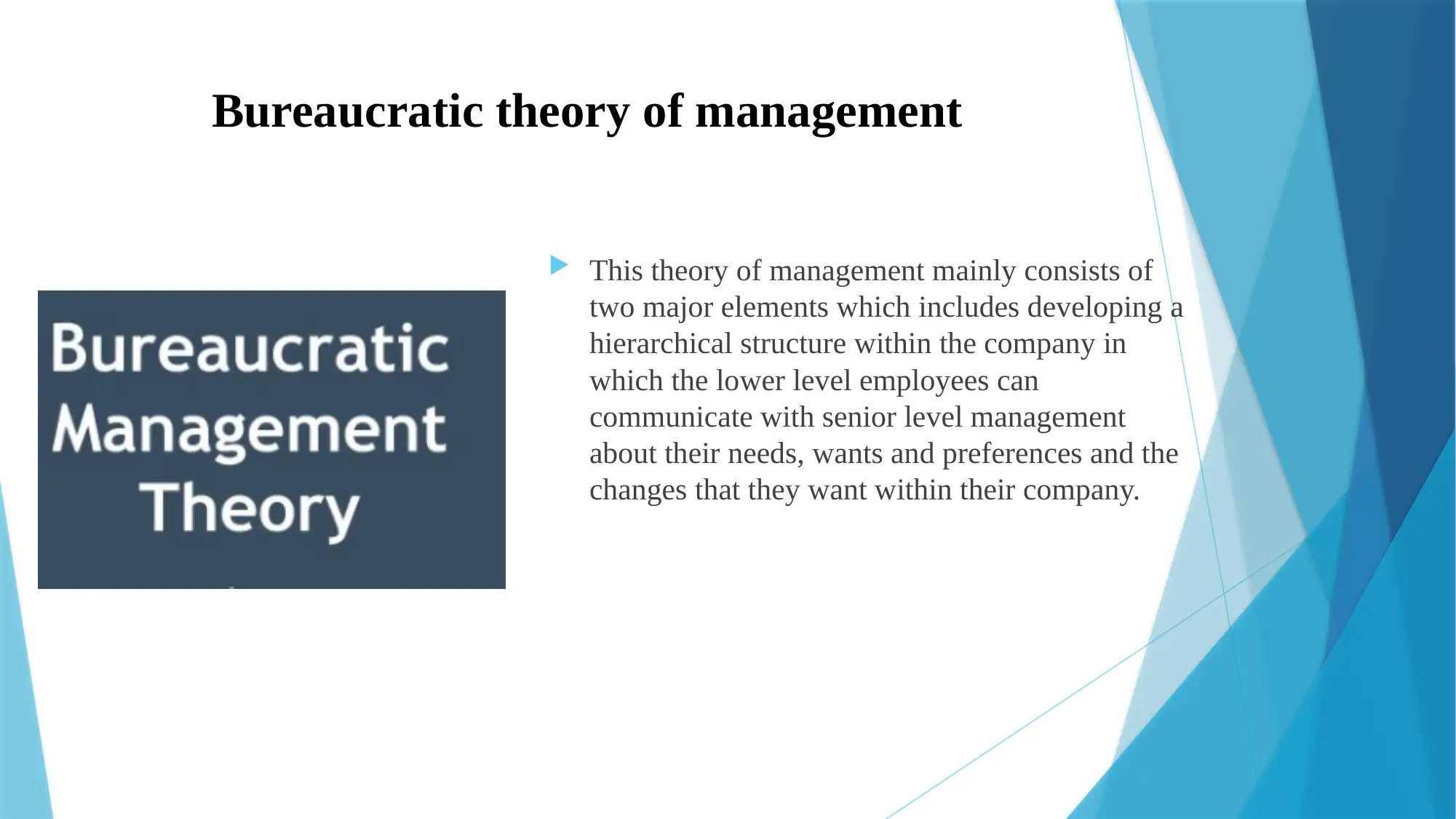
Bureaucratic theory of management
This theory of management mainly consists of
two major elements which includes developing a
hierarchical structure within the company in
which the lower level employees can
communicate with senior level management
about their needs, wants and preferences and the
changes that they want within their company.
This theory of management mainly consists of
two major elements which includes developing a
hierarchical structure within the company in
which the lower level employees can
communicate with senior level management
about their needs, wants and preferences and the
changes that they want within their company.
⊘ This is a preview!⊘
Do you want full access?
Subscribe today to unlock all pages.

Trusted by 1+ million students worldwide
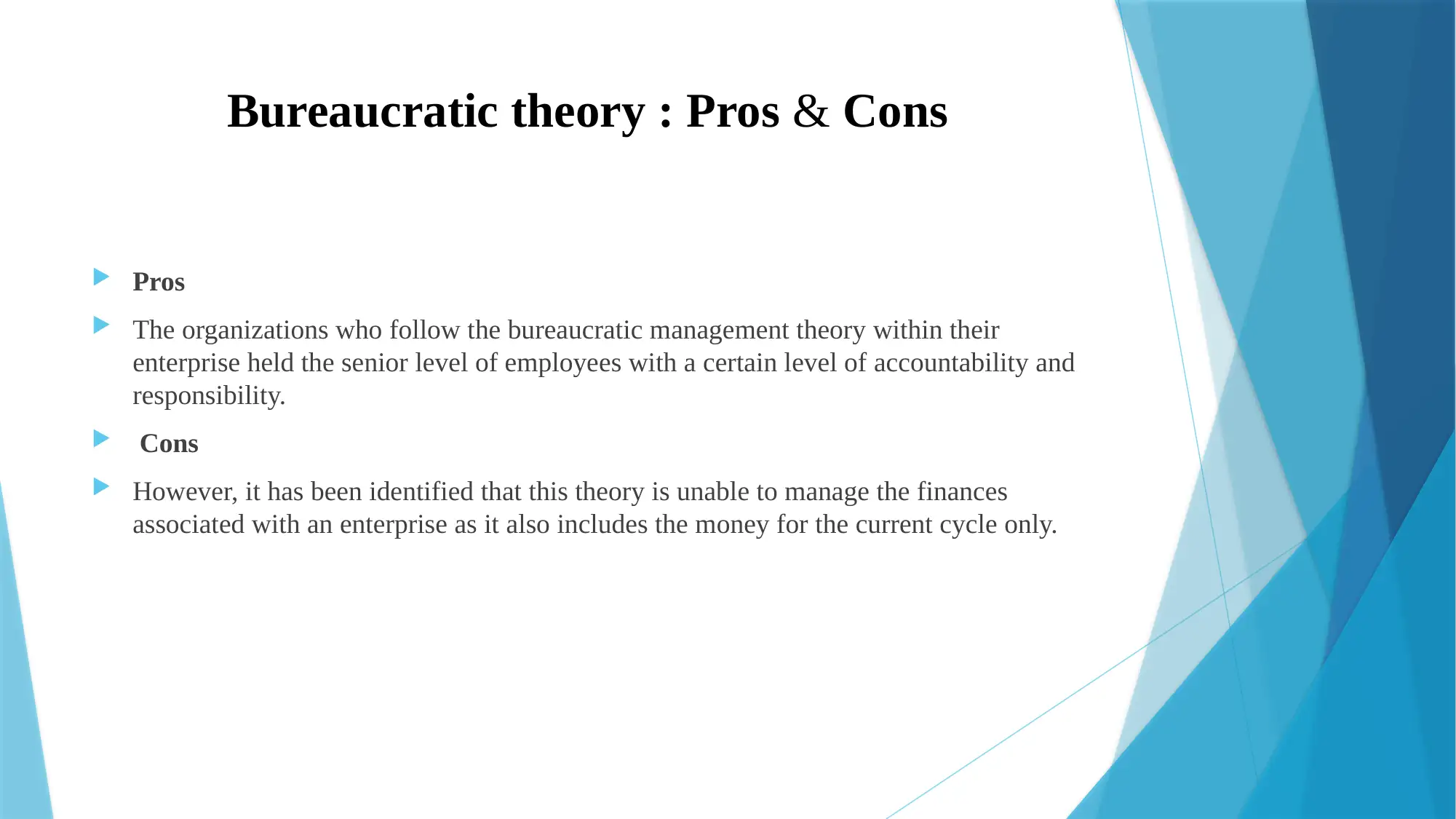
Bureaucratic theory : Pros & Cons
Pros
The organizations who follow the bureaucratic management theory within their
enterprise held the senior level of employees with a certain level of accountability and
responsibility.
Cons
However, it has been identified that this theory is unable to manage the finances
associated with an enterprise as it also includes the money for the current cycle only.
Pros
The organizations who follow the bureaucratic management theory within their
enterprise held the senior level of employees with a certain level of accountability and
responsibility.
Cons
However, it has been identified that this theory is unable to manage the finances
associated with an enterprise as it also includes the money for the current cycle only.
Paraphrase This Document
Need a fresh take? Get an instant paraphrase of this document with our AI Paraphraser

Evaluation of the challenges of leadership and
management in health and social care sector
The major challenges faced by the leaders and managers within the health and social
care sector includes the following:
Rising cost
It has been identified that the cost of treatment and other health related services are
rising rapidly.
The increase in the cost of treatment and other related services are becoming a
challenges for the leaders and managers within this industry as it gets difficult for the
ageing population to visit for treatment at such high prices in this industry.
management in health and social care sector
The major challenges faced by the leaders and managers within the health and social
care sector includes the following:
Rising cost
It has been identified that the cost of treatment and other health related services are
rising rapidly.
The increase in the cost of treatment and other related services are becoming a
challenges for the leaders and managers within this industry as it gets difficult for the
ageing population to visit for treatment at such high prices in this industry.
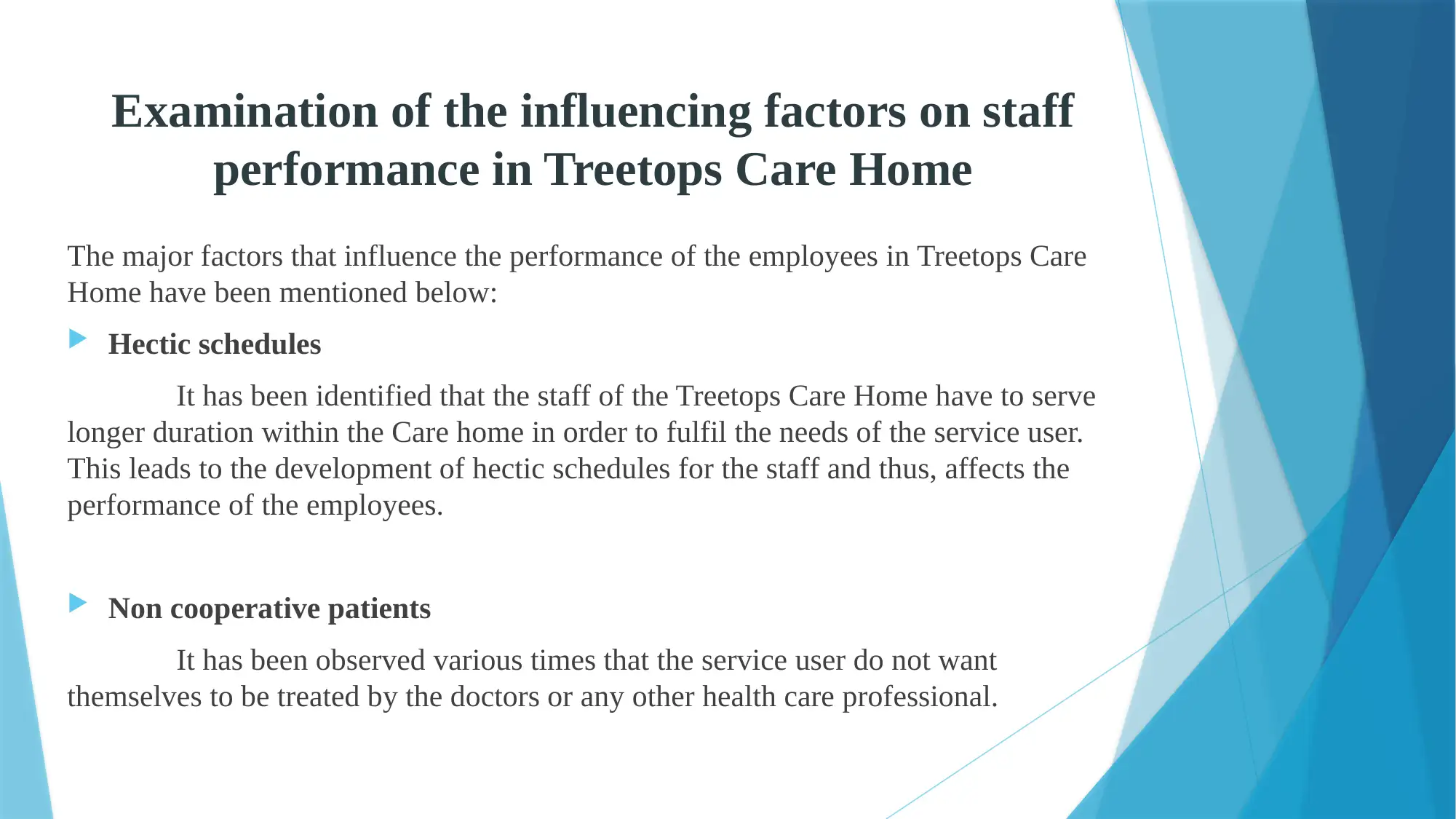
Examination of the influencing factors on staff
performance in Treetops Care Home
The major factors that influence the performance of the employees in Treetops Care
Home have been mentioned below:
Hectic schedules
It has been identified that the staff of the Treetops Care Home have to serve
longer duration within the Care home in order to fulfil the needs of the service user.
This leads to the development of hectic schedules for the staff and thus, affects the
performance of the employees.
Non cooperative patients
It has been observed various times that the service user do not want
themselves to be treated by the doctors or any other health care professional.
performance in Treetops Care Home
The major factors that influence the performance of the employees in Treetops Care
Home have been mentioned below:
Hectic schedules
It has been identified that the staff of the Treetops Care Home have to serve
longer duration within the Care home in order to fulfil the needs of the service user.
This leads to the development of hectic schedules for the staff and thus, affects the
performance of the employees.
Non cooperative patients
It has been observed various times that the service user do not want
themselves to be treated by the doctors or any other health care professional.
⊘ This is a preview!⊘
Do you want full access?
Subscribe today to unlock all pages.

Trusted by 1+ million students worldwide
1 out of 23
Related Documents
Your All-in-One AI-Powered Toolkit for Academic Success.
+13062052269
info@desklib.com
Available 24*7 on WhatsApp / Email
![[object Object]](/_next/static/media/star-bottom.7253800d.svg)
Unlock your academic potential
Copyright © 2020–2025 A2Z Services. All Rights Reserved. Developed and managed by ZUCOL.





